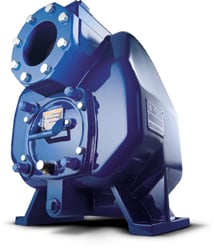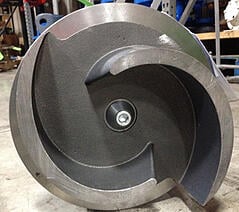110 V Self Prime Continuous Transfer Pump Strong
Self-priming centrifugal pumps are unique. As the name suggests, they have the ability to prime themselves under suction lift conditions. They draw fluid up from tanks or pits below, making them easier and safer to work on than those that work below ground. Under the right conditions, they'll free themselves of entrained gas and function normally on their own, but sometimes, they can't. Why? What causes failure to prime in a self-priming pump? In order to understand why we have to understand how a self-priming pump works. A BRIEF NOTE OF CAUTION: Just because they're able to pull fluid into them, doesn't mean that they should start up dry!! Self-priming pumps need fluid in the casing to get started. Running dry, even for a short while, will cause damage to the mechanical seal, and pump failure. Once the pump is turned on, the impeller begins to turn in a counter clockwise rotation. The fluid inside, or the "initial prime", flows through the volute into the discharge cavity. Here, the air and fluid separate, the air evacuates through an open ended line, or air release line, while the fluid returns to the impeller through a recirculation port. While the fluid is recirculated and the air is removed from the discharge cavity, low pressure is being created at the eye of the impeller. Atmospheric pressure is higher than the lower pressure created at the eye of the impeller, thus fluid is forced up the suction line. As fluid moves up the suction line, the air ahead of the fluid is pushed into the casing and handled as the initial prime was handled through the recirculation process. Once the fluid arrives in the pump, it operates as normal. This video from Gorman-Rupp does a great job showing how a self-priming pump works. That's how it's supposed to work. If that's not the case for you, here are some reasons why your self-priming pump might not prime. As fluid recirculates in the pump and forces air out of the discharge chamber, it's trying to create an area of low pressure. However, if there's a leak in the suction line, air continues to be drawn into the pump, never allowing it to release enough to create that area of low pressure. If the eye of then impeller is plugged with debris, it removes the hydraulic capability of the impeller to create an area of low pressure. A pump can become air bound if it experiences any of these conditions: During the priming process, as discussed above, fluid is recirculated through the volute casing. If the recirculation port becomes plugged, the eye of the impeller is unable to create an area of low pressure in which to pull liquid up the suction line. The ability for self-priming pumps to prime hinges on all the right conditions. The pump must be able to evacuate air from inside the pump, create a low pressure area at the eye of the impeller, and also be properly sized for the right NPSH conditions. Having a pump that won't prime, loses its prime, or is slow to prime? Ask us about it! We gladly provide technical assistance to businesses and municipalities in Wisconsin and upper Michigan. 
HOW A SELF PRIMING PUMP WORKS

WHY YOUR SELF-PRIMING PUMP WON'T PRIME
1. AIR LEAK IN SUCTION LINE
2. DEBRIS IN THE IMPELLER

3. PUMP IS AIR BOUND
4. PLUGGED RECIRCULATION PORT
5. LIFT TOO HIGH FOR PUMP SPEED OR IMPELLER DIAMETER
If you've undersized the pump for the suction line, it will not be able to create the low pressure area it needs to prime. It's important to understand the suction lift requirements before selecting a pump for the application. Use Gorman-Rupp's Pump Selection Guide for the calculations you'll need.

Source: https://blog.craneengineering.net/6-reasons-your-self-priming-pump-wont-prime
0 Response to "110 V Self Prime Continuous Transfer Pump Strong"
Post a Comment